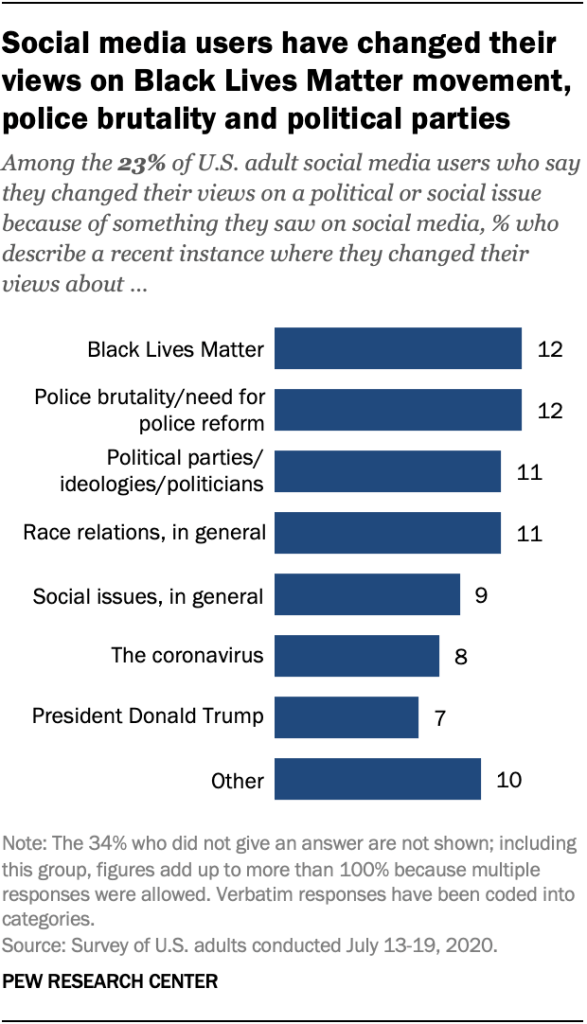Black Lives Matter, the global movement for racial equality, has recently been nominated for the 2021 Nobel Peace Prize. According to the New York Times, BLM could prove to be the largest movement in U.S. history. At its core, it’s a story of anti-violence and civil rights—a narrative echoed through the unprecedented rise and integral role of digital and social media.
At its inception, Black Lives Matter rapidly became a powerful grassroots movement, magnified through digital and social media platforms. Thanks to their social acumen, the organization was able to quickly communicate their message, plan mass events, and rally the global community to action.
Their constant and consistent use of the hashtag #BlackLivesMatter is a prime example of so-called hashtag activism. The hashtag generated significant media coverage and the creation of local chapters. This helped pave the way for BLM to move seamlessly between the digital and the tangible.
Power of the Hashtag
Back in 2013 the hashtag #BlackLivesMatter became ubiquitous across social media. It first emerged following the acquittal of George Zimmerman in the shooting death of unarmed Black teen Trayvon Martin. As the scourge of police brutality failed to subside over the years, the movement only evolved and strengthened. The BLM movement sustained its momentum and activism after the 2014 shooting of Michael Brown by a white police officer.
In a span of just three weeks following the grand jury’s refusal to indict the officer, the #BlackLivesMatter hashtag was used over 1.7 million times on Twitter, according to statistics from Suffolk University.

The year 2020 will no doubt be defined by two separate, albeit linked, crises: the global pandemic and the killing of George Floyd.
As Covid-19 shut down businesses and schools, people trapped in their houses sought refuge on the internet. The pandemic essentially created a captive audience like no other; one with an insatiable appetite for news and information, social interaction, and a window outside of their quarantined lives.
As a result, activity on social media—Facebook, Facebook groups, Twitter, Instagram, YouTube, TikTok—grew exponentially. Today there are an estimated 3.5 billion social media users, which makes up nearly 45% of the global population. That said, social media increased roughly 32% during Covid. For example, there have been 12 billion total views of #BlackLivesMatter on TikTok alone, which boasts more than 500 million active users. Sixty percent are between the ages of 16 to 24 years.
Power of the Video
Last May, in the wake of the fatal police assault of George Floyd in Minneapolis, the BLM movement became arguably even more impactful than ever before, largely due to the social tools available to them. The brutal footage of a white police officer kneeling on Floyd’s neck until he couldn’t breathe—recorded on a bystander’s cellphone and posted to Facebook—went viral. The George Floyd videos were ultimately viewed across social over 1 billion times.
Twitter has historically been the preferred channel for BLM social posts; the #BlackLivesMatter hashtag was used close to 50 million times the week following Floyd’s murder. According to 2020 Twitter trends, #BlackLivesMatter was the second most used hashtag last year (the first was, not surprisingly, #COVID19). Ultimately George Floyd became the third most tweeted-about person in the world.
In the 30 days after Floyd’s death, Black Lives Matter had been mentioned over 80 million times on Twitter, Facebook, Reddit, and various blogs, according to the Social Media Analytics Center at the University of Connecticut.
The sheer volume and reach of social media made it the ideal platform to organize worldwide protests against police brutality. The Drum reported a 4,000% growth in brand use of #BlackLivesMatter on Instagram in May compared to January.
On June 6, half a million people turned out in nearly 550 places across the country to protest systemic racism—despite the pandemic.

Power of the Platform
The fact that BLM is such a force is a credit to the power of outreach through online platforms, social channels and digital tools. However, despite its worldwide recognition, Black Lives Matter remains a decentralized organization with a significant reliance on local chapters. This makes grassroots activity, advocacy and communication critical to its success.
Movements like BLM don’t just change the landscape; they change minds. A 2020 poll conducted by the Pew Research Center found that almost a quarter (23%) of social media users in the U.S. say they have changed their views about a political or social issue because of something they saw on social media.

Power to the People
So what’s next for the Black Lives Matter movement? And how will social and digital media continue to propel them into the future? BLM has already shown over the years that it can adapt to the times and new social platforms. And its mass following of loyal activists across the globe is only growing.
BLM’s decentralized leadership style gives local chapters and activists greater autonomy in outreach and organization. As we have all learned in the past year, social media transcends region and borders among relevant and invested parties.
Last October, Black Lives Matter created the Black Lives Matter political action committee, formalizing their already active involvement in politics and policy. And BLM continues to evolve into more of a multi-racial, multi-cultural movement reflecting today’s changing demographics and environment. For example, with an average age of 28, Latinos are the nation’s youngest major racial or ethnic group. BLM also receives strong support from whites and the LBGTQ community.
So as the the movement broadens and travels faster than even the speed of social, the messaging will broaden as well. Still, it will always be known by the simple three-word hashtag that started it all: Black Lives Matter.
Photo by Samuel Regan-Asante on Unsplash





Join the conversation